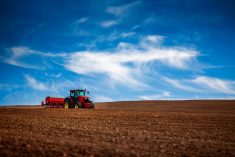Farm business models aren’t keeping up, and our farms are losing out as a result
Financial and farm advisers throw around terms like “model” and “strategy” coupled with other words like “innovative” and “new,” as though we should all be excited about them.
Siblings James Kuhl and Kristen Gray at River Valley Specialty Farms embrace the ideas these words create, maybe because they’ve managed to use new and innovative models and strategies to point their farm business in a direction that fits their passion.
Read Also

Winter downtime: Organize your farm records now for smoother operation
How to organize farm finances paperwork
But for many farmers who struggle to get more production out of their farm, or to make more money, or to meet goals to enrich their personal lives, these terms are just euphemisms, words that mean change.
And as we all know, change is hard.
So what is the key to making those changes that will help farm managers to reach their business goals? While there is no one model or strategy to fit the needs of every farm, it helps to break the process down to its simplest form.
“Examine where you’re at and where you’d like to be in the future, and the strategy is how you get there,” says Terry Betker at Backswath Management in Winnipeg. “It is no more complicated than that.”
The process may not be complicated, but making a decision can be. Betker encourages farm families to look at the future, set goals, test the financial feasibility of an idea and then plan. And the more people involved, he suggests, the more important it is to clearly set out a vision, to define what the farm is working toward, and to have everyone on board.
Betker also suggests using the services of a facilitator to lead this discussion because often on the farm “we have a lot of talk, but not a lot of focused discussion.”
If knowing your goal is key, so too is understanding why you’re doing what you’re doing.
“Will a good idea put you any further ahead than doing nothing?” Betker challenges. “That discussion is largely about the numbers because it separates business from emotion. It creates a context. The numbers don’t make the decision; the numbers create the context for the decision.”
For example, in the last number of years there’s been more profit made in agriculture and so more cash on the farm. This context allowed producers to be more proactive and develop new strategies as opportunities presented themselves. But as margins tighten up, it is financial profitability that drives decisions, and so strategies to save money become more reactive.
Betker believes that farm business models have not kept pace with change on the farm. He sees a lack of ideas that are both innovative and cost effective, though he points to a small number of farms finding ways to do both.
Some use models designed to manage capital investment, like sharing drying systems or sprayers. Or they manage operational costs, such as sharing the services of an agronomist. Some large farms want to get more productivity out of their human resources, so they pool together to hire a consultant who spends one day a week at each farm.
Models can be traditional or alternative, Betker says. “They can be revenue-based, niche, or value-added. Even downsizing is a model, depending on where you’re at. But all models have to first start with a close look at what you’ve got.”
Then, when the plan is in place, there must be follow-through.
Change is hard. Building a new business model for your farm and deciding on strategies to achieve your goals can be overwhelming. But starting with where the farm is at, determining where it needs to be and charting a course to get there, seems a pretty straightforward remedy for the fear that might accompany such an endeavour.














